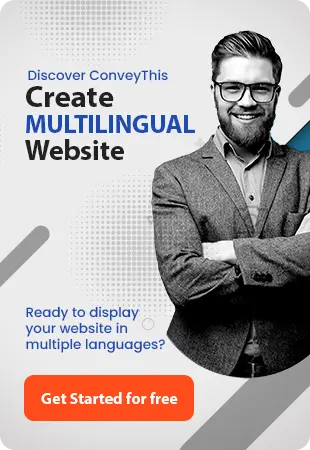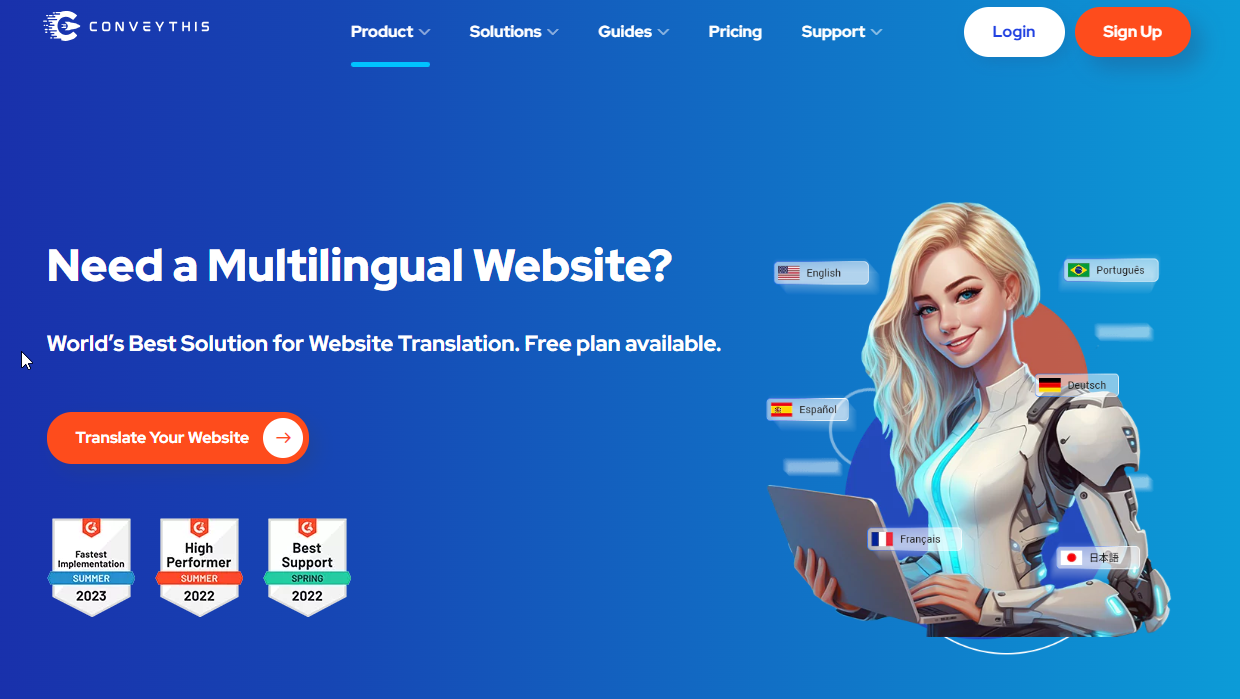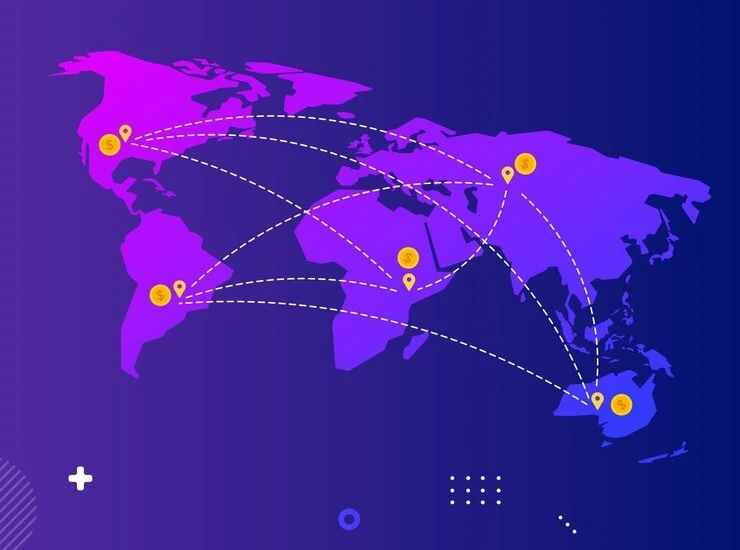Hvor meget koster det at oversætte et websted: En omfattende vejledning
Hvor meget koster det at oversætte en hjemmeside?
Omkostningerne ved at oversætte et websted er en vigtig overvejelse for virksomheder, der ønsker at ekspandere globalt. Spørgsmål som "Hvor meget koster det egentlig at oversætte mit websted?" og "Hvad koster et flersproget websted?" opstår ofte ved planlægning af denne investering.
Svaret afhænger af flere faktorer, herunder det samlede antal ord på dit websted, de involverede sprog, det nødvendige tilpasningsniveau, og om du vælger maskin- eller menneskelige oversættelser – eller en kombination af begge. Nedenfor opdeler vi omkostningerne og trinene, der er involveret i at oversætte dit websted effektivt.
Det grundlæggende: Oversættelsesomkostninger og hvad de dækker
Omkostningerne til oversættelse af websteder varierer baseret på flere faktorer, hvilket gør det vigtigt for virksomheder at forstå, hvad der påvirker prissætningen. Professionelle oversættelsestjenester opkræver typisk på et ord-basis med priser, der spænder fra $0,09 til $0,30 per ord , afhængigt af kompleksiteten og omfanget af projektet. Der er dog andre elementer at overveje, såsom lokaliseringsbehov, specialiseret indhold og projektdeadlines.
Faktorer, der påvirker oversættelsesomkostninger
1. Sprogpar
Omkostningerne ved oversættelse afhænger ofte af de involverede sprog:
- Udbredte sprog: At oversætte fra engelsk til populære sprog som spansk, fransk eller tysk er mere overkommeligt på grund af en større pulje af oversættere og lavere ubalance mellem efterspørgsel og udbud.
- Mindre almindelige sprog: Sjældne sprogpar, såsom islandsk, swahili eller oprindelige sprog, koster mere, fordi færre fagfolk specialiserer sig i dem.
- Tovejs kompleksitet: Nogle sprogpar er i sagens natur mere komplekse, især når der oversættes mellem sprog med forskellige scripts (f.eks. engelsk til kinesisk eller japansk).
2. Specialiseret indhold
Indholdstypen påvirker oversættelsesomkostningerne markant:
- Teknisk indhold: Industrier som teknik, IT eller videnskab kræver ofte fageksperter, hvilket hæver prisen.
- Juridiske og medicinske dokumenter: Disse oversættelser kræver præcision og overholdelse af specifikke terminologier, som kan koste op til $0,50 pr. ord eller mere .
- Kreativt indhold: Marketingkampagner eller brand storytelling involverer ofte transcreation, en blanding af oversættelse og kreativ tilpasning, som er dyrere end standardoversættelse.
3. Ekspeditionstid
Haster kan øge omkostningerne:
- Standard turnaround: Projekter med fleksible deadlines er mere overkommelige.
- Rush-projekter: Oversættere kan opkræve en præmie for stramme deadlines, især for store eller komplekse projekter.
- Store mængder: Rabatter kan være tilgængelige for bulk ordtælling, men fremskyndede tjenester kan ophæve disse besparelser.
Typer af omkostninger i webstedsoversættelse
Webstedsoversættelsesprojekter involverer typisk to hovedtyper af udgifter: oversættelsesomkostninger og lokaliseringsomkostninger .
1. Oversættelsesomkostninger
Dette dækker den direkte oversættelse af dit websteds indhold, herunder:
- Produktbeskrivelser.
- Blogs og artikler.
- Kontaktoplysninger og ofte stillede spørgsmål.
Oversættelsesomkostninger beregnes ud fra det samlede ordantal og tekstens kompleksitet.
Eksempel:
For et websted på 10.000 ord:
- Lavpris: $900 (ved $0,09 pr. ord).
- Avanceret pris: $3.000 (ved $0,30 pr. ord).
2. Lokaliseringsomkostninger
Lokalisering går ud over at oversætte ord for at sikre, at indholdet er kulturelt relevant og funktionelt egnet til målgruppen . Det omfatter:
- Kulturel tilpasning: Justering af idiomer, billeder og tone, så de stemmer overens med lokale normer.
- Formateringsændringer: Ændring af layouts for at rumme sprog med længere tekst, såsom tysk, eller scripts, der kræver yderligere mellemrum, såsom kinesisk.
- Funktionel test: Sikring af, at det oversatte websted fungerer problemfrit, herunder navigation, formularer og interaktive elementer.
Eksempel på lokaliseringsomkostninger: Et websted med multimedieelementer som videoer eller infografik kan kræve:
- Undertekstoversættelse eller voiceover-oversættelse.
- Visuelle justeringer af grafik eller bannere.
- Funktionstest på forskellige enheder og browsere.
Disse yderligere tjenester kan tilføje 15-30 % til de samlede projektomkostninger.
Professionelle oversættelsestjenester: Omkostningsfordeling
1. Traditionelle agenturer
Agenturer som Translation Services USA opkræver mellem $0,15 og $0,30 pr. ord. De giver ofte:
- Professionelle oversættere og redaktører.
- Stilguider og ordlister.
- Sproglig QA for at sikre nøjagtighed og konsistens.
2. ConveyThis
ConveyThis tilbyder en mere overkommelig løsning ved at blande neural maskinoversættelse med valgfri menneskelig korrekturlæsning:
- Maskinoversættelsesomkostninger: Så lave som $0,004 pr. ord.
- Menneskelige korrekturlæsningsomkostninger: Omkring $0,09 pr. ord for højkvalitetsoversættelser på sprog som spansk, fransk, tysk og kinesisk.
Eksempel:
En hjemmeside på 2.500 ord oversat til ét sprog:
- Maskinoversættelse: $10.
- Menneskelig korrekturlæsning: $225.
Dette repræsenterer en omkostningsreduktion på op til 50 % sammenlignet med traditionelle oversættelsesbureauer.
Reduktion af omkostninger til oversættelse af websteder
1. Automatiserede oversættelser med menneskelig forfining
Ved at bruge værktøjer som ConveyThis kan du generere indledende oversættelser med maskinlæring og forfine dem med menneskelige oversættere. Denne tilgang balancerer overkommelighed med kvalitet.
2. Fællesskabsbaserede oversættelser
Hvis dit websted har et engageret fællesskab, kan du invitere brugere til at bidrage med oversættelser. Sørg dog for, at du har værktøjer til at overvåge kvalitet og konsistens.
3. Fokuser på højprioritetssider
Ikke alle sider behøver muligvis oversættelse. Start med vigtige sektioner som:
- Hjemmeside
- Produktbeskrivelser
- Kasseproces
- Ofte stillede spørgsmål om kundesupport
Webteknologiske udfordringer og omkostninger
Opbygning af et flersproget websted handler ikke kun om at oversætte tekst – det involverer at håndtere en række tekniske udfordringer for at sikre, at webstedet fungerer problemfrit på tværs af sprog og regioner. Forberedelse af din hjemmeside til en flersproget oplevelse kræver nøje overvejelse af kodning, rammer, teksthåndtering, designjusteringer og SEO-optimering. Nedenfor går vi dybere ned i disse fælles udfordringer og leverer handlingsrettede løsninger.
1. Teknisk kodning
Kodning er rygraden i enhver flersproget hjemmeside. For at vise tegn fra forskellige sprog korrekt skal dit websted understøtte en universel kodningsstandard.
Udfordringer:
- Mange ældre websteder bruger kodningsstandarder, der ikke kan understøtte komplekse scripts eller specialtegn, hvilket fører til visningsfejl.
- Uden korrekt kodning vil sprog med unikke tegn – såsom kinesisk, arabisk eller kyrillisk – fremstå som forvansket tekst.
Løsninger:
- Adopter UTF-8-kodning: UTF-8 er den mest udbredte kodningsstandard, der er i stand til at understøtte stort set alle tegn og scripts.
- Bekræft aktuel kodning: Tjek dit websteds aktuelle kodning, og opdater den om nødvendigt. De fleste CMS-platforme, som WordPress, tilbyder indbygget understøttelse af UTF-8.
- Test på tværs af sprog: Udfør test for at sikre, at alle sprog vises korrekt på forskellige enheder og browsere.
Omkostninger:
Hvis dit websted ikke er designet med moderne kodning i tankerne, kan du få udviklingsomkostninger for at opgradere dit system. Investeringen sikrer dog langsigtet kompatibilitet med et globalt publikum.
2. Ansøgningsrammer
Dit websteds Content Management System (CMS) og backend-rammer skal være i stand til at håndtere flersproget indhold effektivt.
Udfordringer:
- Lagringsbegrænsninger: Nogle CMS-platforme understøtter muligvis ikke native lagring af flersprogede versioner af dit indhold.
- Dynamisk indhold: Opdatering eller synkronisering af dynamisk indhold, såsom produktkataloger eller brugergenererede anmeldelser, kan blive en kompleks opgave.
Løsninger:
- Brug flersprogede-kompatible platforme: Platforme som WordPress, Shopify, Wix og Squarespace tilbyder plugins eller indbyggede værktøjer til flersproget administration. ConveyThis integreres problemfrit med disse platforme, hvilket muliggør ubesværet sprogskift.
- Databasekonfiguration: Sørg for, at din database er struktureret til at gemme og hente sprogspecifikt indhold effektivt.
- Automatiseringsværktøjer: Implementer værktøjer, der automatiserer processen med at opdage, gemme og administrere flersproget indhold.
Omkostninger:
Tilpasning af dit CMS eller backend-rammer til flersprogede funktioner kan medføre engangsopsætningsomkostninger. Værktøjer som ConveyThis reducerer imidlertid behovet for omfattende manuel indgriben, hvilket reducerer de løbende udgifter.
3. Tekstudtræk og reintegration
Håndtering af tekststrenge til oversættelse er en kritisk teknisk hindring, især for websteder med dynamiske eller interaktive elementer.
Udfordringer:
- Udpakning af indlejret tekst (f.eks. i billeder eller JavaScript-filer) kan være tidskrævende.
- Genindsættelse af oversat tekst uden at forstyrre funktionaliteten kræver omhyggelig planlægning.
Løsninger:
- Automatiseringsværktøjer: Platforme som ConveyThis automatiserer tekstudtræk og reintegration og strømliner oversættelsesprocessen.
- Cloud-baseret oversættelsesstyring: Brug værktøjer som SDL Trados eller Smartling til at administrere tekststrenge og sikre jævn reintegration.
- Minimer indlejret tekst: Undgå at indlejre tekst i ikke-redigerbare elementer som billeder eller videoer. Brug overlejringstekst eller billedtekster i stedet.
Omkostninger:
Mens automatiseringsværktøjer forenkler teksthåndtering, kan indledende integration involvere udviklingsomkostninger, især for specialkodede websteder.
4. Visuelle justeringer
Sprogforskelle kan have stor indflydelse på dit websteds design og layout. Nogle sprog kræver mere plads, mens andre kan ændre indholdsstrømmen fuldstændigt.
Udfordringer:
- Tekstudvidelse: Fransk og spansk tekst udvides ofte med op til 30 %, hvilket kræver mere plads i knapper, menuer og tekstbokse.
- Script-specifikke justeringer: Kinesiske og japanske tegn kan have brug for øget linjeafstand, mens højre-til-venstre (RTL) sprog som arabisk og hebraisk kræver spejlede layouts.
- Problemer med responsivt design: Flersproget indhold skal forblive responsivt på tværs af enheder, inklusive mobilskærme.
Løsninger:
- Fleksible layouts: Design dit websted med adaptive layouts, så det kan rumme forskellige tekstlængder og justeringer.
- Dynamiske UI-komponenter: Brug dynamisk ændring af størrelse til elementer som knapper, faner og menuer.
- Højre-til-venstre (RTL)-kompatibilitet: For RTL-sprog skal du spejle hele grænsefladen for at bevare brugervenligheden.
Omkostninger:
At tilpasse dit websted til flersprogede visuelle krav involverer design- og udviklingsindsatser, men disse er afgørende for at sikre en poleret brugeroplevelse på tværs af alle sprog.
5. Lokalisering til SEO
Flersprogede websteder skal konfigureres til søgemaskineoptimering (SEO) for at rangere effektivt i forskellige regioner.
Udfordringer:
- Hreflang-tags: Uden korrekt hreflang-implementering kan søgemaskiner kæmpe for at vise den korrekte sprogversion af dit websted.
- Lokaliserede søgeord: Direkte oversættelser af søgeord stemmer muligvis ikke overens med regional søgeadfærd.
- URL-optimering: URL'er skal lokaliseres for at forbedre søgesynlighed.
Løsninger:
- Hreflang-tags: Tilføj hreflang-tags til dit websteds HTML for at signalere sprog- og regionsspecifikke versioner til søgemaskiner.
- Lokaliseret indhold: Udfør regional søgeordsundersøgelse for at sikre, at dit indhold er målrettet mod relevante udtryk.
-
SEO-venlig URL-struktur: Brug undermapper (f.eks.
example.com/fr) eller underdomæner (fr.example.com) for hvert sprog.
Omkostninger:
Implementering af flersproget SEO kan kræve ansættelse af SEO-specialister eller brug af platforme som ConveyThis, som inkluderer indbyggede SEO-værktøjer. Disse bestræbelser er uvurderlige for at drive organisk trafik fra internationale målgrupper.
Så, "Hvor meget koster det egentlig at oversætte min hjemmeside?" og "Hvad koster et flersproget websted" .
For at beregne prisen på, hvor meget det vil koste at oversætte/lokalisere din hjemmeside, skal du få et samlet omtrentligt antal ord på din hjemmeside. Brug det gratis onlineværktøj: WebsiteWordCalculator.com
Når du kender antallet af ord, kan du gange det på ord-basis for at få omkostningerne ved maskinoversættelsen.
Med hensyn til ConveyThis priser ville prisen på 2500 ord oversat til ét ekstra sprog koste 10 USD eller 0,004 USD pr. ord. Det er den neurale maskinoversættelse. At korrekturlæse det med mennesker, vil det koste $0,09 pr. ord.
Trin 1: Automatiseret hjemmesideoversættelse
Takket være fremskridt inden for neural machine learning kan du nu hurtigt oversætte hele websteder ved hjælp af værktøjer som ConveyThis. Automatiseret oversættelse giver et omkostningseffektivt udgangspunkt for at skabe en flersproget hjemmeside.
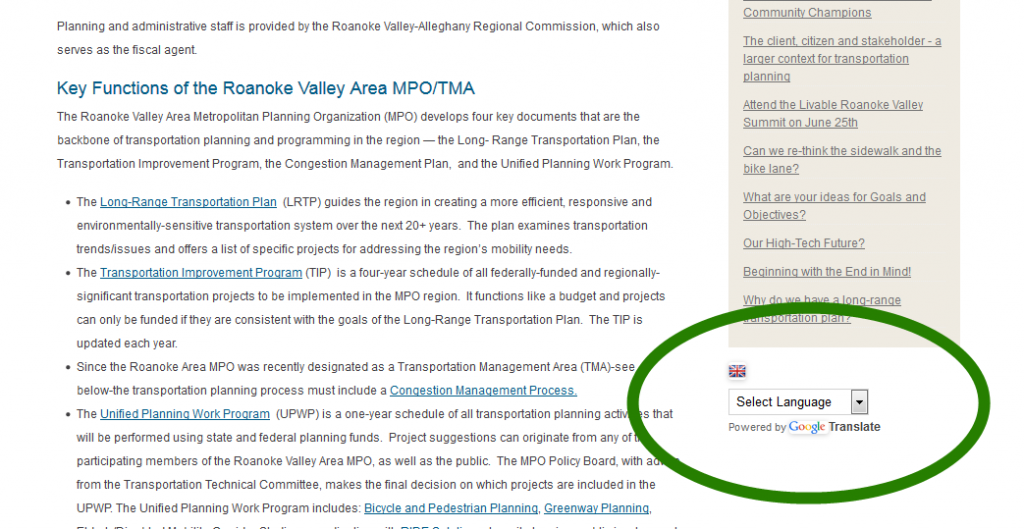
Fordele ved automatiseret oversættelse:
- Hastighed: Maskinoversættelse er næsten øjeblikkelig, så dit websted kan gå live på flere sprog inden for få minutter.
- Omkostningseffektivitet: Automatiseret oversættelse er betydeligt billigere end manuelle metoder, med omkostninger så lave som $0,004 pr. ord.
- Nem opsætning: Platforme som ConveyThis tilbyder en enkel 5-minutters opsætningsproces for at gøre dit websted flersproget uden teknisk ekspertise.
Automatiske oversættelser alene er dog ikke nok til professionelle resultater. De mangler SEO-funktioner og kan producere fejl eller unaturlige formuleringer. Det er her, menneskelig raffinement bliver afgørende.
Trin 2: Menneskelig oversættelse til præcision og kulturel tilpasning
Når din hjemmeside er automatisk oversat, er næste skridt at forfine indholdet med menneskelige oversættere. Menneskelig indgriben sikrer nøjagtighed, kulturel relevans og brandkonsistens.
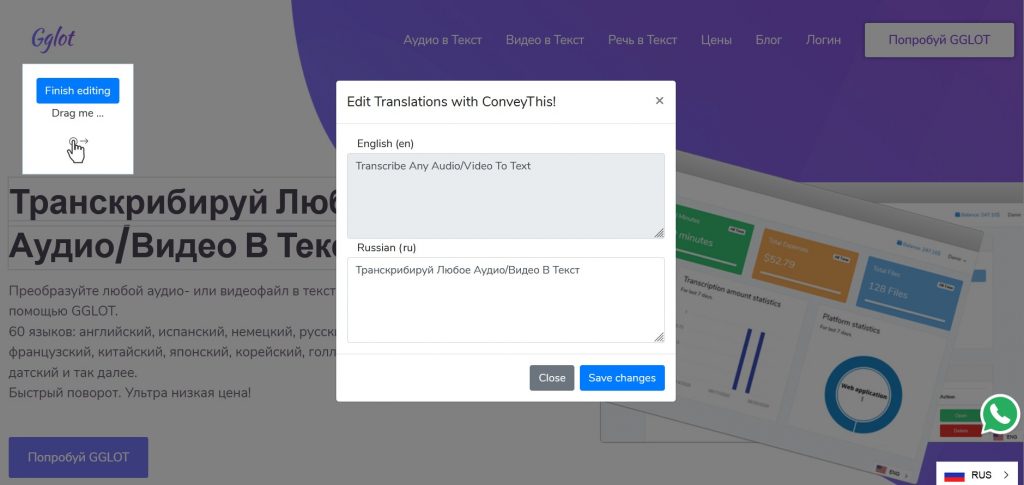
Muligheder for menneskelig oversættelse:
- Selvredigering: Hvis du er tosproget, skal du bruge ConveyThiss Visuelle editor til selv at foretage rettelser og forbedre oversættelser.
- Lej professionelle oversættere: Til komplekse eller flersprogede projekter, hyr eksperter ved hjælp af ConveyThiss onlinebestillingsfunktion. Professionelle lingvister kan håndtere sprog som arabisk, tysk, japansk, koreansk, russisk og mere.
Hvorfor menneskelig forfining er vigtig:
- Eliminerer fejl: Retter unøjagtigheder i maskinoversættelser.
- Forbedrer læsbarheden: Sikrer naturlig frasering og tone.
- Kulturel relevans: Tilpasser indhold til din målgruppes præferencer.
Trin 3: Optimering til flersproget SEO
En af de største fordele ved at bruge en platform som ConveyThis er dens fokus på SEO-optimering til flersprogede websteder.
Nøgle SEO-funktioner:
- HREFLANG Tags: Hjælp søgemaskiner med at identificere sprogversioner af dine sider.
-
Lokaliserede URL'er: Opret SEO-venlige URL'er for hvert sprog (f.eks.
example.com/frfor fransk). - Metadata-oversættelse: Oversætter automatisk meta-titler, beskrivelser og alt-tekst for bedre placering i søgemaskinerne.
Dette sikrer, at dit oversatte indhold ikke kun er nøjagtigt, men også kan opdages, hvilket driver organisk trafik fra globale markeder.
Trin 4: Yderligere funktioner til tilpasning
Ekskluder sider fra oversættelse:

Ikke alle sider skal oversættes. ConveyThis giver dig mulighed for at ekskludere specifikke sider, reducere omkostningerne og sikre, at følsomt eller unødvendigt indhold forbliver uoversat.
Slå oversættelser til eller fra:
Administrer nemt dit flersprogede websted ved at slå automatiske oversættelser til eller fra med en simpel kontakt.
Platform kompatibilitet:
ConveyThis integreres problemfrit med platforme som:
- WordPress (inklusive plugins til SEO-fordele)
- Shopify
- Weebly
- Wix
- Squarespace
Dette gør det til en ideel løsning for virksomheder på tværs af forskellige brancher.
Alternativer: Flere websteder vs. flersproget integration
Når virksomheder opretter et flersproget websted, står virksomheder ofte over for en afgørende beslutning: Skal de bygge separate websteder for hvert sprog eller integrere flersproget funktionalitet på et enkelt websted? Selvom det i første omgang kan virke ligetil at vedligeholde individuelle websteder for hvert sprog, fører det ofte til betydelige udfordringer med hensyn til skalerbarhed, vedligeholdelse og overordnet effektivitet. Her udforsker vi fordele og ulemper ved hver tilgang, og hvorfor flersproget integration typisk er det smartere valg.
Separate websteder for hvert sprog
Nogle organisationer vælger at oprette forskellige websteder for hvert sprog eller område. For eksempel kan de have separate domæner someksempel.frfor fransk ogeksempel.defor tysk. Selvom denne tilgang giver visse fordele, introducerer den også væsentlige ulemper.
Fordele:
-
Regionsspecifik tilpasning:
Separate websteder giver mulighed for meget skræddersyet indhold og brugeroplevelser, der er specifikke for et land eller en region. Du kan lokalisere visuals, produkter og endda marketingstrategier. -
Uafhængig præstationssporing:
Hvert websted fungerer uafhængigt, hvilket gør det nemmere at overvåge specifikke regionale præstationer uden indblanding fra andre markeder. -
Lovlig overholdelse:
Individuelle websteder kan skræddersyes fuldt ud til at opfylde lokale regulatoriske krav, såsom datalagringslove eller tilgængelighedsstandarder.
Ulemper:
-
Højere udviklings- og vedligeholdelsesomkostninger:
Administration af flere websteder kræver separat hosting, designopdateringer og regelmæssig vedligeholdelse for hvert domæne, hvilket øger udgifterne markant. -
Fragmenteret analyse:
Konsolidering af indsigt fra separate websteder kan være udfordrende, hvilket komplicerer bestræbelserne på at spore brugeradfærd og webstedsydelse på tværs af regioner. -
Reduceret SEO-effektivitet:
Hver hjemmeside skal bygge sin egen SEO-autoritet, der ofte konkurrerer med andre sprogversioner af det samme indhold. Dette kan udvande dit brands online synlighed. -
Begrænset skalerbarhed:
Tilføjelse af nye sprog kræver opbygning af helt nye websteder, hvilket er tidskrævende og ressourcekrævende.
Integreret flersproget funktionalitet
Integrering af flersprogede muligheder på et enkelt websted giver virksomheder mulighed for at betjene forskellige sproglige målgrupper fra én centraliseret platform. Platforme som ConveyThis gør denne tilgang enkel, effektiv og yderst skalerbar.
Fordele:
-
Omkostningseffektivitet:
Med et enkelt websted undgår du at duplikere infrastrukturomkostninger som hosting, design og backend-systemer. Oversættelser administreres centralt, hvilket reducerer overhead. -
Centraliseret ledelse:
Opdateringer af indhold, design eller funktionalitet skal kun foretages én gang, hvilket sikrer ensartethed på tværs af alle sprogversioner. -
Konsolideret analyse:
Integrerede flersprogede websteder giver dig mulighed for at spore brugeradfærd på tværs af sprog fra et enkelt dashboard. Værktøjer som Google Analytics kan give et samlet overblik over, hvordan forskellige regioner interagerer med dit indhold. -
SEO-fordele:
Platforme som ConveyThis inkluderer funktioner som:- Hreflang-tags: Hjælp søgemaskiner forstå sprogspecifikt indhold.
- Lokaliserede webadresser: Undermapper (f.eks.
example.com/fr) eller underdomæner (fr.example.com) forbedre søgemaskinernes placeringer for specifikke regioner og samtidig konsolidere SEO-autoriteten.
-
Skalerbarhed:
Tilføjelse af et nyt sprog er ligetil med flersprogede platforme. Processen er automatiseret, hvilket reducerer tid og indsats sammenlignet med at skabe en helt ny hjemmeside. -
Konsekvent branding:
Flersproget integration sikrer, at dit websted bevarer det samme branding, udseende og følelse på tværs af alle sprog, hvilket giver en sammenhængende brugeroplevelse.
Hvorfor flersproget integration er en bedre løsning
Værktøjer som ConveyThis forenkler processen med at oprette og administrere et flersproget websted ved at tilbyde:
- Automatiseret oversættelse: Oversæt hurtigt et helt websted med neural maskinoversættelse.
- Tilpasningsmuligheder: Forfin oversættelser manuelt eller hyr professionelle lingvister til kritisk indhold.
- SEO-integration: Sørg for, at oversatte sider er indekseret korrekt for maksimal synlighed.
- Platformkompatibilitet: Integrer problemfrit med CMS-platforme som WordPress, Shopify, Wix og mere.
Eksempel på effektivitet:
Forestil dig at administrere et globalt e-handelswebsted med 10 sprog. Ved at bruge separate websteder skal hver produktopdatering eller promovering anvendes individuelt på hvert websted - et logistisk mareridt. Med flersproget integration foretages opdateringer én gang og synkroniseres automatisk på tværs af alle sprog, hvilket sparer tid og ressourcer.
Når separate websteder kan give mening
I sjældne tilfælde kan det være berettiget at vedligeholde separate websteder, såsom:
- Meget specialiserede markeder: Hvis regionalt indhold eller produkter er drastisk forskellige, såsom i industrier som fast ejendom eller juridiske tjenester.
- Juridiske eller regulatoriske begrænsninger: Nogle regioner kan pålægge krav, der nødvendiggør separat infrastruktur.
- Distinkte brandingstrategier: Når et brands identitet eller markedsføringstilgang varierer betydeligt på tværs af regioner.
Selv i disse tilfælde kan virksomheder ofte nå de samme mål med en robust flersproget platform og omhyggelig tilpasning.
Yderligere overvejelser for flersprogede websteder
Oprettelse af en flersproget hjemmeside kræver omhyggelig planlægning for at sikre en problemfri oplevelse for brugere over hele verden. Ud over oversættelse og lokalisering er der adskillige tekniske og regulatoriske aspekter at overveje. Her er et udvidet kig på vigtige overvejelser for at sikre, at dit flersprogede websted fungerer optimalt og overholder globale standarder.
1. Mobil kompatibilitet
I dagens mobile-first-verden er det afgørende at sikre, at dit flersprogede websted er fuldt responsivt på mobile enheder. Mobilkompatibilitet er ikke kun en bekvemmelighed – det er en nødvendighed for at nå ud til brugere i regioner, hvor smartphones er det primære middel til internetadgang.
Nøgleovervejelser:
- Responsivt design: Din hjemmeside skal tilpasse sig forskellige skærmstørrelser og -retninger. Sørg for, at oversat tekst passer pænt ind i mobile layouts, da nogle sprog (f.eks. tysk eller finsk) kan udvide teksten betydeligt.
- Ydeevneoptimering: Optimer dit websted til hastighed på mobile enheder ved at komprimere billeder, bruge effektiv kodningspraksis og udnytte Content Delivery Networks (CDN'er).
- Mobil SEO: Sørg for, at dine mobilversioner af oversatte sider er korrekt indekseret af søgemaskiner. Brug værktøjer som Googles mobilvenlige test til at identificere problemer.
- Applokalisering: Hvis din virksomhed også bruger mobilapps, skal du sørge for, at disse apps er lokaliseret sammen med dit websted. Platforme som ConveyThis kan hjælpe med at synkronisere indhold på tværs af begge.
2. Test på tværs af regioner
Globalt publikum bruger en bred vifte af enheder, browsere og internethastigheder, hvilket gør test på tværs af regioner afgørende for at levere en ensartet brugeroplevelse.
Vigtige testtrin:
- Browserkompatibilitet: Test dit websted på populære browsere som Chrome, Safari, Firefox og Edge for at sikre korrekt gengivelse af flersproget indhold.
-
Regionale enheder: Tjek kompatibilitet på enheder, der er populære i bestemte regioner. For eksempel:
- iOS- og Android-enheder i Nordamerika og Europa.
- Xiaomi eller Huawei-enheder i Kina.
- Internethastigheder: Optimer dit websted til forskellige internethastigheder. For eksempel skal du sikre, at billeder og videoer indlæses effektivt i områder med langsommere forbindelser.
- Geolocation-nøjagtighed: Test funktioner som valutavisning og lokaliseret indhold for at sikre nøjagtighed baseret på brugernes placering.
Værktøjer til regional test:
- BrowserStack: Tillader test på forskellige enheder og browsere eksternt.
- Geolocation VPN'er: Simuler browsing fra forskellige regioner for at verificere lokaliseret indhold og funktioner.
3. Lovlig overholdelse
Overholdelse af lokale lovkrav er afgørende for driften af et flersproget websted, især hvis du målretter mod regioner med strenge regler vedrørende onlineindhold og brugerrettigheder.
Almindelige juridiske krav:
-
Sprogspecifikke juridiske dokumenter: Visse regioner kræver, at juridiske dokumenter som vilkår og betingelser, privatlivspolitikker og ansvarsfraskrivelser er tilgængelige på det lokale sprog. For eksempel:
- Den Europæiske Unions GDPR kræver, at databeskyttelsesoplysninger er tilgængelige på brugerens sprog.
- Canadas lov om officielle sprog kræver indhold på både engelsk og fransk.
- Tilgængelighedsstandarder: Sørg for, at dit flersprogede websted overholder tilgængelighedslove såsom Web Content Accessibility Guidelines (WCAG) eller regionale standarder som Americans with Disabilities Act (ADA) i USA
- Forbrugerbeskyttelseslove: Mange regioner kræver gennemsigtighed i produktbeskrivelser, priser og returneringspolitikker. Sørg for, at disse er nøjagtigt oversat og lokaliseret.
- Overholdelse af skat og fakturering: Lokaliser faktureringsoplysninger, herunder skatteoplysninger, i overensstemmelse med lokal lovgivning.
Sådan opnår du overholdelse:
- Lej juridiske oversættere: Brug professionelle oversættere med erfaring i juridisk indhold for at sikre nøjagtighed.
- Arbejd med regionale eksperter: Rådfør dig med lokale juridiske rådgivere for at bekræfte overholdelse af regionale regler.
- Regelmæssige opdateringer: Overvåg ændringer i lovkrav på dine målmarkeder og opdater dit websted i overensstemmelse hermed.
Konklusion: Er det det værd at oversætte dit websted?
At oversætte dit websted er en investering, der kan åbne din virksomhed til nye markeder og øge den globale rækkevidde markant. Selvom omkostningerne afhænger af faktorer som ordantal, kompleksitet og de involverede sprog, tilbyder løsninger som ConveyThis overkommelige og skalerbare muligheder for virksomheder i alle størrelser.
Sådan bestemmer du dine omkostninger:
- Beregn dit websteds ordantal ved hjælp af værktøjer som WebsiteWordCalculator.com .
- Multiplicer med satser pr. ord for maskinelle eller menneskelige oversættelser.
- Medtag ekstra omkostninger til lokalisering, SEO og tekniske justeringer.
Ved at udnytte moderne teknologier og strategisk planlægning kan du skabe en flersproget hjemmeside, der fremmer engagement, forbedrer brugeroplevelsen og genererer højere omsætning – uden at bryde banken. Hvis du er klar til at starte, så kontakt os for et gratis prisoverslag eller prøv ConveyThiss gratis prøveperiode i dag!
Yderligere ressourcer:
- ConveyThis integrationer for at udforske kompatibilitet med WordPress.
- Sådan oversætter du WordPress for mere vejledning.
- Hjælpevejledning til oversættelse af WordPress-websteder for trin-for-trin support.
Oversættelse, langt mere end blot at kunne sprog, er en kompleks proces.
Ved at følge vores tips og bruge ConveyThis vil dine oversatte sider få genklang hos dit publikum, og føle sig hjemmehørende i målsproget.
Selvom det kræver indsats, er resultatet givende. Hvis du oversætter et websted, kan ConveyThis spare dig for timer med automatisk maskinoversættelse.
Prøv ConveyThis gratis i 7 dage!
